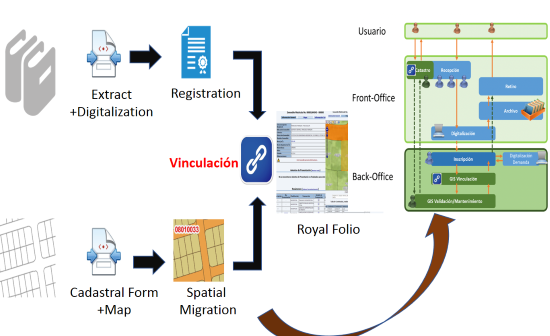Decentralization of Registry-Cadastre services in the public sector
This is the abstract of an interesting exhibition that will happen in the Annual Land and Property Conference, sponsored by the World Bank in the coming days of March 2017. Alvarez and Ortega will present on the experience of deconcentrating Registry / Cadastre services on a Front-Back Office model, in this case Private Banking, in accordance with the declaration of 2014 Cadastre "In the future, the private sector and the public sector will work together."
The decentralization of property services has been included as one of the necessary requirements to address the challenges that arise in the growth of transactional volume barter of property assets, in the increase of users' expectations in improving the Quality of services, decrease costs and response times that entails the registration of a good.
By means of this mechanism The National System of Property Administration of Honduras (SINAP), seeks to undertake the route towards decentralization hoping to achieve efficiency, transparency, mobility in transactions; thus creating greater mobilization in the land market.
The antecedent of a decentralized administration.
 The Property Administration System of Honduras, based on the Property Law approved by decree 82-2004, empowers the Property Institute to appoint and regulate Associated Centers to operate and administer the registry services that depend on the Property Institute, considering that the administration of services through a public-private alliance has more agile mechanisms and procedures to respond to the requirements required for the constitution and dynamization of a stock market.
The Property Administration System of Honduras, based on the Property Law approved by decree 82-2004, empowers the Property Institute to appoint and regulate Associated Centers to operate and administer the registry services that depend on the Property Institute, considering that the administration of services through a public-private alliance has more agile mechanisms and procedures to respond to the requirements required for the constitution and dynamization of a stock market.
In July 2006, the first Associated Center was formed, delegating it to the Chambers of Commerce and Industries of Honduras, to operate and administer the Mercantile Registry, said registry includes the services that the registration of company constitutions and registration of partner movements entails. and capital.
In April 2016, the second Associated Center was formed, the first one in the matter of Registration-Cadastre, delegating to the Honduran Bank for Production and Housing (BANHPROVI), to manage and operate the registry transactions related to the portfolio of clients that access the BANHPROVI funds for home loan.
In October, 2016 formed the third Associated Center, the second in terms of Registration-Cadastre, delegating Banco Financiera Comercial Hondureña SA (FIHCOSA) to administer and operate the registry transactions related to the portfolio of clients that access the FIHCOSA funds for loan of living place.
Through this decentralization mechanism of registry services, SINAP seeks to promote the economic and effective management of state resources, through the interventions of both the private sector, civil society and international cooperation agencies, avoiding the Duplication of efforts.
The implementation of the Associated Centers as a decentralization mechanism for the Property Administration in Honduras.
 With an annual growth of 12.7% in transactions in the Property Registries, a Front and Back Office model is implemented in order to improve the traceability and transparency of transactions in the property registers, but it was not possible to reduce the times response to the end user.
With an annual growth of 12.7% in transactions in the Property Registries, a Front and Back Office model is implemented in order to improve the traceability and transparency of transactions in the property registers, but it was not possible to reduce the times response to the end user.
Once validated from the model in the Property Registry, I facilitate the creation of Associated Centers Registry-Cadastre to operate under the regulations and in a single technological platform established by the Property Registry Office of Honduras.
Why the Banking?
Private banking moves an average of 31 million dollars annually in mortgages on real estate sales is therefore the main actor in reducing the response times in the inscription of these transactions on real estate.
Benefits to the Property System in Honduras.
Optimize public administration, improving services to citizens through a solid and efficient banking network, where all movements are subject to rigorous audit processes.

Norms, control and monitoring of operations.
Each operation center will be subject to the rules and procedures established by the Directorate of Property Records, such as regulations, procedural agreements, operating manuals and certification guidelines.
It will be good later to know the complete 10-page document, and the PowerPoint that rather than being applied to copy and paste, is useful to understand how a developing country can visualize a business model with an end-user approach. Of course, the lessons learned and failed attempts before reaching this point will surely be of further use and worthy of another lecture.





